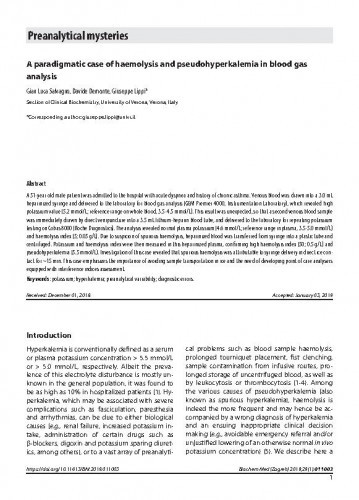A 51-year old male patient was admitted to the hospital with acute dyspnea and history of chronic asthma. Venous blood was drawn into a 3.0 mLheparinized syringe and delivered to the laboratory for blood gas analysis (GEM Premier 4000, Instrumentation Laboratory), which revealed highpotassium value (5.2 mmol/L; reference range on whole blood, 3.5-4.5 mmol/L). This result was unexpected, so that a second venous blood samplewas immediately drawn by direct venipuncture into a 3.5 mL lithium-heparin blood tube, and delivered to the laboratory for repeating potassiumtesting on Cobas 8000 (Roche Diagnostics). The analysis revealed normal plasma potassium (4.6 mmol/L; reference range in plasma, 3.5-5.0 mmol/L)and haemolysis index (5; 0.05 g/L). Due to suspicion of spurious haemolysis, heparinized blood was transferred from syringe into a plastic tube andcentrifuged. Potassium and haemolysis index were then measured in this heparinized plasma, confirming high haemolysis index (50; 0.5 g/L) andpseudohyperkalemia (5.5 mmol/L). Investigation of this case revealed that spurious haemolysis was attributable to syringe delivery in direct ice contactfor ~15 min. This case emphasizes the importance of avoiding sample transportation in ice and the need of developing point of care analysersequipped with interference indices assessment.
Sažetak

 Biochemia medica : the journal of Croatian Society for Medical Biochemistry and Laboratory Medicine : 29,1(2019) / glavna i odgovorna urednica Daria Pašalić.
Biochemia medica : the journal of Croatian Society for Medical Biochemistry and Laboratory Medicine : 29,1(2019) / glavna i odgovorna urednica Daria Pašalić.